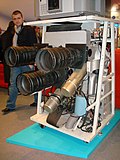Eidophor
The Eidophor system (Swiss patent) was the first method for large-area projection of television images . It was invented in 1939 by the Swiss engineer Fritz Fischer at the ETHZ . The name is borrowed from the Greek and can be translated as image carrier . The further development took place first at Dr. Edgar Gretener AG, which was later renamed GRETAG AG.
In order to demonstrate the application for cinema halls for the first time on April 11, 1958, an Eidophor projector was installed in the Cinema Rex in Zurich and a Swiss television program was transmitted and shown on the cinema screen via a microwave connection. However, the hoped-for application for radio transmission of films in projection rooms did not catch on.
However, Eidophor was still used in the professional sector for large events, universities, monitoring centers (NASA) and flight simulators until the late 1980s. From the 1970s onwards, tube projectors consisting of special cathode ray tubes combined with suitable projection optics were available as alternatives for relatively small projection surfaces such as flight simulators and home cinemas .
As replacement products, cheaper LCD ( liquid crystal display ) and DLP ( digital light processing ) video projectors appeared on the market from the 1990s , with preliminary work on the corresponding LCD technology being carried out in Switzerland (probably the world's first projector demonstration with LCD matrix display of modest resolution as a light modulator by Peter J. Wild , Brown, Boveri & Cie 1972).
Working principle
Beam path
With the Eidophor system, the light from a high-performance xenon gas discharge lamp is directed into a concave mirror via louvre- shaped bar mirrors (lattice mirrors ). Opposite the concave mirror there is a converging lens or the objective which projects all the light rays that pass through the slits of the bar mirror onto the screen . Since the bar mirror is symmetrical and is exactly in the center of the concave mirror, all of the light is reflected back into the source and the screen initially remains dark.
Beam path in one variant
As an alternative to the concave mirror, in some devices the oil film was applied to a glass plate in a tube. Before and after the tube with the glass plate, grille panels (instead of the grille mirror) were attached so that the second grille panel blocks the light let through by the first grille arrangement and the screen remains dark.
Image generation
To create an image, the light has to be deflected along the beam path so that it can pass the mirror bars. For this purpose, the concave mirror is a component or anode of a cathode ray tube . A thin layer of oil (approx. 14 μm thick) is applied to the concave mirror, which is scanned by the electron beam and bombarded with electrons to different degrees depending on the video signal . The oil layer is deformed locally, which causes a slight deflection of the light. The reflected light beams then no longer hit the bar mirror exactly, but pass it or the second bar grid arrangement and are projected as a point onto the screen by the objective (converging lens).
The deflection on the deformed oil film is caused by the optical diffraction at a phase grating or by refraction similar to the Schlieren optics.
Color projections can be achieved by using three parallel Eidophor systems with appropriate color filters.
Alternatively, one system can also be used if a color filter wheel is also arranged in the beam path ( color sequence method ).
Fully developed Eidophor systems had an excellent image quality for the time.
literature
- Ernst Baumann: The Eidophor - a Swiss development of large-scale television projection . (PDF) Zurich 1961
- F. Mast: Recent developments in the Eidophor process. In: Festschrift for the 60th birthday of Prof. Dr. hc E. Baumann. Hasler Works Foundation. Working Group for Electrical Communications Technology (AGEN), Zurich 1969, No. 10, pp. 72–77
- Caroline Meyer: The Eidophor: A large screen projection system between cinema and television 1939-1999. (Interferences - studies on the cultural history of technology, 15). Chronos-Verlag, Zurich 2009, ISBN 978-3-0340-0988-1 .
Web links
- The story of the Eidophor projector. ETHistory
Individual evidence
- ↑ Twenty years of large- scale television projection. Neue Zürcher Zeitung, May 10, 1959, p. A39
- ↑ Hugo Thiemann: TV pictures in the cinema - GRETAG impresses Hollywood greats with the Eidophor . In: Franz Betschon et al. (Ed.): Engineers build Switzerland - first-hand technology history . Verlag Neue Zürcher Zeitung, Zurich 2013, ISBN 978-3-03823-791-4 , pp. 439–445
- ^ Heinrich Johannes: The History of the Eidophor Large Screen Television Projector. Gretag Aktiengesellschaft (Ed.), Regensdorf 1989.
- ↑ Juri Jaquemet: Swiss technology on the moon. nationalmuseum.ch, accessed on March 28, 2019
- ↑ Sony Corporate History sony.net, accessed May 11, 2020
- ↑ Peter J. Wild: Swiss contributions to LCD development (English)
- ↑ How does it work? The technology in today's life . 2nd Edition. Bibliographisches Institut, 1978, ISBN 3-411-01732-5 , pp. 208-209 .



